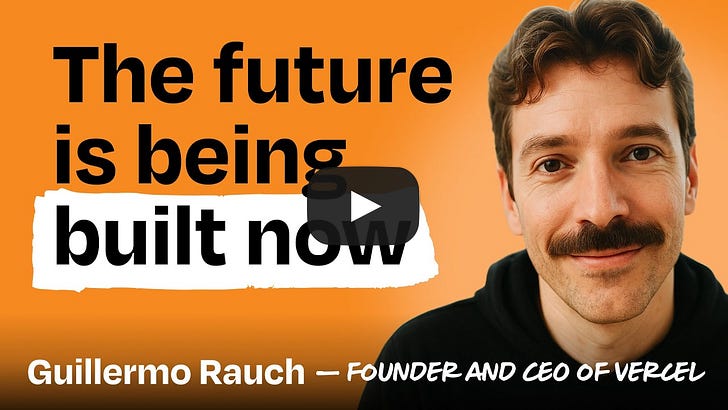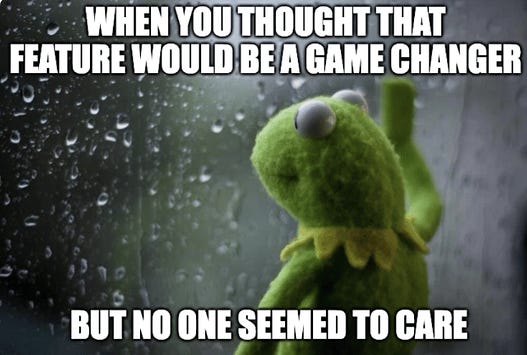🧠 Community Wisdom: Setting priorities across distributed teams, moving from manager to IC, upskilling your desig…
👋 Hello and welcome to this week’s edition of ✨ Community Wisdom ✨ a subscriber-only email, delivered every Saturday, highlighting the most helpful conversations in our members-only Slack community. A big thank-you to this month’s community sponsor, Merge! Merge makes integrating with your customers’ software vendors easy. Add hundreds of integrations to your B2B SaaS products, with unified APIs for file storage, ticketing, CRM, ATS, HRIS, and accounting. AI companies love Merge because it delivers instant, secure access to clean customer data that powers their solutions. Stop wasting countless engineering hours staying ahead of breaking API changes and digging through a backlog of integration support tickets. Merge handles the full integration lifecycle so you can focus on what matters most: building your core product! ✨ Upcoming community meetups ✨Upcoming community-organized meetups—click the city name to RSVP:
Can’t find your city and want to host one? Just DM @Riya in our Slack. It takes 10 minutes (i.e. pick a date and location), and you get to meet awesome people from our community. Learn more here. 🎙️ New podcast episode this weekEveryone’s an engineer now: Inside v0’s mission to create a hundred million builders | Guillermo Rauch (founder & CEO of Vercel, creators of v0 and Next.js): YouTube // Apple // Spotify  💥 Top threads this week1. Setting priorities across distributed teams
Christoph Steinlehner: It sounds like you will be part of a platform team (using the mental model of Team Topologies ← might be an interesting model to look deeper into). It’s important not to fall into the dependency trap, where other teams are blocked by your team. I would start by identifying the ‘interfaces’ your enabling tech has for the other teams. Make a list of things (APIs, documentation, Repos, etc.) and clarify how the teams are currently communicating. Also, understand how direction and decisions are currently made. There will be some culture around this; understand what’s working well and what’s not working well. ‘Prioritization’ shouldn’t very much differ from typical product work. What is the bigger strategy, what are the biggest levers? But your main ‘customer’ will be the other teams. Paul Howard: Hey, @Mason, congratulations on the new role! It sounds like you’ll be leading a platform team that builds reusable components used across the organization—a shift from working on a single product line. Here are a few things to think about:
Best of luck! Mason: Thanks, Christoph and Paul! Super-helpful framing, and gives me more to dig into. Joni Hoadley: I’ve been a bit of a broken record on this suggestion: consider using a PM Role Canvas to work through this and get alignment. I have a template you can check out. DM me if you’re interested and I’ll share the link. Joshua Herzig-Marx: One important thing to figure out early on: who sets your roadmap? It may not be obvious on day 1! Shivam Malhotra: All great tips above. Keep in mind, the end outcome you drive will remain the same, but the how-to will change. For instance, you want to talk about how your components are enabling an increase in users but at scale across multiple teams. When we started our platform team as a fintech with 4 p&ls, here were my 3 biggest learnings:
2. Technical talent vs. product experience
Ashwin: If you want to hire a junior PM for an API product management role, then you will quickly find out how many complaints you get from your partners and customers. I’d suggest hiring a developer advocate instead at first, assuming you can get that under your org. S Isaac: @Ashwin, can you share more about what kind of challenges you think a junior person in this role would face and why? Do you think juniors don’t have enough knowledge or taste to work through API execution challenges, or something else? I’ve worked with developer advocates at plenty of other companies, but they don’t make much sense for our business. We’re looking for someone who can take reasonably defined feature requests and work with eng to finish scoping and execution. Suchita Kaundin: I moved into product (early in product) after years in technical roles, and I’ve found that folks who’ve had to bridge the gap between engineering and customers can thrive in roles like this if they’ve had some exposure to product thinking. Your description of the role—API-heavy, reading docs, mapping feasibility, working with engineers and customers—really resonates. If it’s helpful as you think through the JD or pipeline strategy, happy to chat. Here’s my background for context. Emmanuel Paraskakis: My best API PMs have come from engineering. That being said, if a PM has a technical slant, perhaps a coding background, they can also pick things up fast. This role sounds more like an “inbound”-type PM than “outbound,” right? In that case, you’ll need the API know-how first. A couple of items off the top of my head: (1) check out my post on hiring API PMs, (2) look through my network on LI if you see any suitable folks. Krishna AG: I would move an engineer looking to move into PM who is very solid into this role, good communication, clarity in thinking etc. being prerequisites. S Isaac: Thanks much for the replies. I’ll look through in more detail tomorrow. QQ, what’s an inbound vs. outbound PM, @Emmanuel Paraskakis? Emmanuel Paraskakis: @S Isaac, While I’m not a fan of the concept, some organizations have “mostly customer-facing” PMs and “mostly internal-facing” ones. Almost like the PM/PO concept. The reason I’m not a fan is because things get lost in translation with this separation. But I’ve been in large orgs where this worked. In those cases, the “inbound” folks closely correlate with the “technical” PMs. S Isaac: I see what you’re saying. This PM will definitely be working with customers. But executing on any part of our product will require API knowledge? Thanks again for the replies! I’ll make the wording clear that we’re open to folks coming from a variety of backgrounds who have the skills that would make someone successful in the role (tech skills, communication, and organization). I’m happy to share the job description with anyone here when it’s done. Would love to chat if you know anyone who would be a good fit. Please feel free to DM. @Emmanuel Paraskakis, also, great blog post. Going to borrow some of this process! Emmanuel Paraskakis: That’s what it’s there for. Glad it’s useful! 3. Moving from manager to IC
John Conneely: I’d argue that in the modern world of AI product management, your influence as an IC is limited by your own curiosity and ability to offset the mundane tasks with AI tooling. If the company you have an offer from has any of the main enterprise AI platforms available for you to use to help with your workload (Gemini/ChatGPT etc.), then you should be able to have plenty of influence in an SPM role. That’s exactly the role I have now, and I’m helping to create the new way of working for our division. The IC PM role of 3 years ago is a completely different beast to today. JP: I agree with the above. My more senior PMs have nearly as much influence as my People Leaders. Whitney Gibbs: I agree and I feel like the switch between IC and people manager is happening much more frequently than you think, especially switching between companies. As middle management continues to evolve, companies are focusing there for cost savings. Also, if you’re not happy as a manager, don’t worry what other people think. You’re doing yourself and your possible direct reports a favor. Mounica Veggalam: It sounds like you’re dealing with a lot of uncertainty and ambiguity. Do you enjoy the people management part? Do you feel passionate about growing people? If yes, you can have a significant impact on your people and the product part of the role, even if the management is not mature. I call this increasing your “fitness to uncertainty” and leading people with that capacity. It seems clear that you care about your reports. Since it’s an early-stage startup, you can grow very quickly and build essential business skills that’d be useful in your later roles. So does this line of thinking sound interesting? Feel free to DM and I can talk more about it. If not, whether you’re moving to IC or not, if you could have any career, what would you be building? Sitting with that question may give some ideas and expand possibilities. 4. Strategic approaches to PM workload management
James Conway: What are you interested in learning about? Personally, you would struggle to get me excited about QA even if you paid me extra (it would have to be a lot extra!). Follow your pains/needs: Where is your product weak? What do you need to have a stronger understanding of? You won’t be able work on everything in one go, so you don’t need to learn everything. Shivam Malhotra: Been there many years ago, definitely sounds like growing pains. I had to make a shift from doing and tracking everything yourself to designing a system that runs without you in every detail. Like James said, you don’t need to and can’t do it all. The goal is to create a self-reliant team. A few things that come to mind:
Joshua Herzig-Marx: Is the challenge keeping up with industry discussions and your personal development? As others have said, you need to set a sustainable budget (e.g. 3 hours of reading a week, only one podcast because I hate podcasts) and try to limit yourself. There’s too much happening in tech. Are you trying to keep up with your team? If you’re the single product manager on a single cross-functional product team, then the trick is to do fewer things. The most time-consuming and stressful work will be handoffs and cross-team synchronization, and you deal with those by minimizing or eliminating cross-team work and bringing your engineering and design colleagues in at the beginning to minimize handoffs. If you have multiple teams for which you’re PM, then it will be largely impossible. . . 5. Upskilling your design capabilities as a PM
Mikhail Morgan: Sounds like a cool merger of interest. Learning the fundamentals of graphic design and color theory will help you connect some dots and study other designs that resonate with you in your everyday life more effectively. There’s a ton of different ways to do that, but here’s what I typically suggest for folks:
Whitney Meer: Thank you, @Mikhail Morgan! Great call/reminder on Abstract. I watched it when it came out, and I think about the lighting designer episode all the time. Definitely time for a rewatch. Miroslav Pavelek: Completely different approach:
There are many (free) design systems, like Material Design, Ant Design, MUI and others you may adopt. They already have many components and design patterns resolved, so that way, you could keep your focus more on UX/workflow and less on “how to make nice table.” It is not a silver bullet, but it can straightaway resolve like 80% of the UI issues you may have. Mayank: Here is an alternative approach: Copy the design you like—colors, typography and UI elements.
Lucia Wang: Hi Whitney, this is an interesting challenge you’re facing. I have worked as a UX/product designer for 8 years and happy to hop on a quick huddle to hear about your learning needs, as I’m developing a resource just for this. I posted this survey in a different channel. In terms of learning design the old-fashioned, pre-AI way, some resources I’d recommend:
There are many topics under the “Design” umbrella, so maybe you’d want to decide whether you want to learn design psychology, interaction design, UI design or just the UX principles. Angela Smith: I think it’s good practice to look regularly at examples of “good” design, using tools like Mobbin.com. 🤓 Top finds
😂 Meme of the weekHave a fulfilling and productive week 🙏 If anyone in your life would benefit from this newsletter or community, consider giving them a gift subscription 💞 There are group discounts, gift options, and referral bonuses available. Sincerely, Kiyani 👋 Invite your friends and earn rewardsIf you enjoy Lenny's Newsletter, share it with your friends and earn rewards when they subscribe. |
Similar newsletters
There are other similar shared emails that you might be interested in:
- 🧠 Community Wisdom: Essential reading for early-stage founders, balancing unlimited SaaS plans with profitability…
- 🧠 Community Wisdom: Finding your voice on established teams, focus tips for ADHD brains, how to best use Granola,…
- 🧠 Community Wisdom: Designing great performance review templates, balancing oversight and autonomy with junior te…

